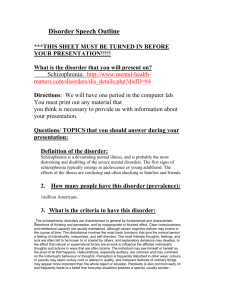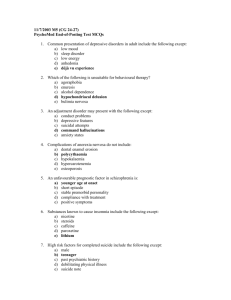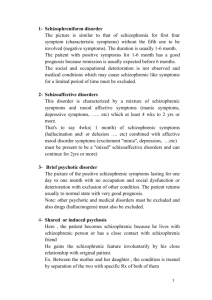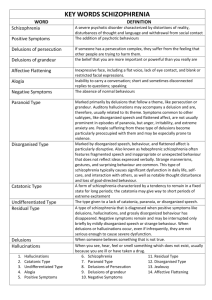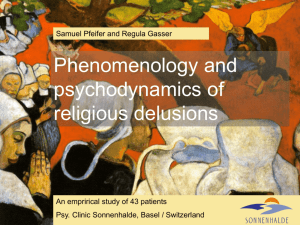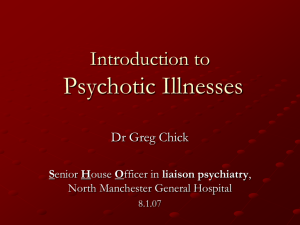Chapter 12
advertisement
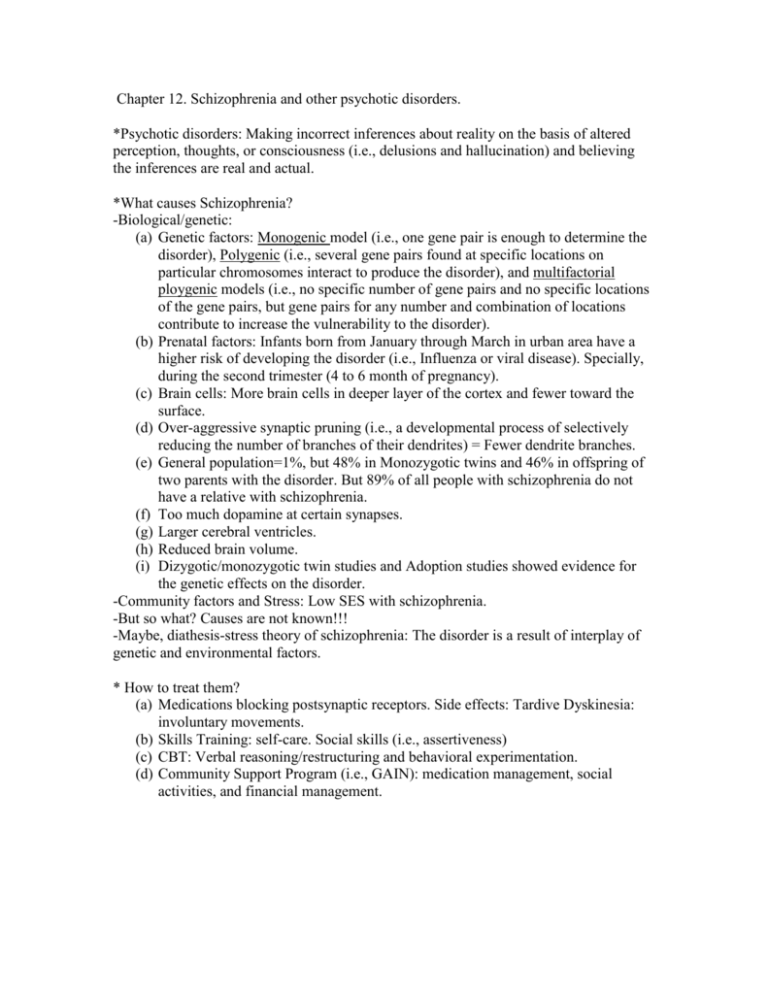
Chapter 12. Schizophrenia and other psychotic disorders. *Psychotic disorders: Making incorrect inferences about reality on the basis of altered perception, thoughts, or consciousness (i.e., delusions and hallucination) and believing the inferences are real and actual. *What causes Schizophrenia? -Biological/genetic: (a) Genetic factors: Monogenic model (i.e., one gene pair is enough to determine the disorder), Polygenic (i.e., several gene pairs found at specific locations on particular chromosomes interact to produce the disorder), and multifactorial ploygenic models (i.e., no specific number of gene pairs and no specific locations of the gene pairs, but gene pairs for any number and combination of locations contribute to increase the vulnerability to the disorder). (b) Prenatal factors: Infants born from January through March in urban area have a higher risk of developing the disorder (i.e., Influenza or viral disease). Specially, during the second trimester (4 to 6 month of pregnancy). (c) Brain cells: More brain cells in deeper layer of the cortex and fewer toward the surface. (d) Over-aggressive synaptic pruning (i.e., a developmental process of selectively reducing the number of branches of their dendrites) = Fewer dendrite branches. (e) General population=1%, but 48% in Monozygotic twins and 46% in offspring of two parents with the disorder. But 89% of all people with schizophrenia do not have a relative with schizophrenia. (f) Too much dopamine at certain synapses. (g) Larger cerebral ventricles. (h) Reduced brain volume. (i) Dizygotic/monozygotic twin studies and Adoption studies showed evidence for the genetic effects on the disorder. -Community factors and Stress: Low SES with schizophrenia. -But so what? Causes are not known!!! -Maybe, diathesis-stress theory of schizophrenia: The disorder is a result of interplay of genetic and environmental factors. * How to treat them? (a) Medications blocking postsynaptic receptors. Side effects: Tardive Dyskinesia: involuntary movements. (b) Skills Training: self-care. Social skills (i.e., assertiveness) (c) CBT: Verbal reasoning/restructuring and behavioral experimentation. (d) Community Support Program (i.e., GAIN): medication management, social activities, and financial management. *Delusion: A false belief based on incorrect inference about external reality despite what constitutes incontrovertible and obvious proof or evidence to the contrary. (a) Bizarre: A delusional thought that is implausible in a culture. (b) Delusional jealousy: Delusional thought that one’s partner is unfaithful. (c) Erotomanic: A delusional thought that another person (i.e., higher status) is in love with the person. (d) Grandiose: A delusion of inflated worth, power, knowledge, identity, or special relationship to a deity or famous person. (e) Mood-congruent: A delusion that is consistent with the person’s mood (i.e., depression, manic) (i.e., depressed Will be punished. Manic inflated worth) (f) Mood-incongruent: A delusion that is inconsistent with the person’s mood (i.e., depression, manic) (i.e., thought insertion, thought broadcasting). (g) Delusions of being controlled: Feelings, thoughts, or actions are experienced as being under control of some external force. (h) Delusions of reference: Events, objects, or other persons in one’s immediate environment have a particular and unusual significance. (i) Persecutory: A delusion in which one is being attacked, harassed, or cheated. (j) Somatic: A delusion pertaining to one’s appearance or functioning of one’s body. (k) Thought broadcasting: One’s thoughts are broadcasted out loud so that the person’s thought can be perceived by others. (l) Thought insertion: One’s thoughts are not one’s own, but inserted into one’s own. *Hallucination: A sensory perception without external stimulation of the relevant sensory organ. (a) Auditory: (b) Gustatory: (c) Mood-congruent (i.e., manic seeing Elvis). (d) Mood-incongruent (the content of hallucination does not involve either depression or manic) (e) Olfactory: (f) Somatic: The perception of a physical experience localized within the body (i.e., a feeling of electricity). (g) Tactile: Feeling being touched or something is under one’s skin. (h) Visual: *Illusions: A misperception or misinterpretation of a real external stimulus (i.e., hearing the rustle of leaves as the sound of voices). Diagnoses: 1. Schizophrenia Disorder: 2 or more of the following symptoms persisting at least 6 months (significant portion of time during a 1-month period). (a) Delusions (b) Hallucinations (c) Disorganized speech (i.e., frequent Derailment such as a person’s ideas slip off one track into another that is completely unrelated or Incoherent such as derailment within a clause in contrast to between two clauses). (d) Grossly disorganized or Catatonic (i.e., Motoric immobility such as stupor or catalepsy, Excessive motor activity such as purposeless agitation, Extreme negativism, Mutism, Stereotyped movements, Echolalia/echopraxia) behavior (e) Negative symptoms (i.e., affective flattening such as avoidance of eye contact, immobile face, monotonous voice, apathy/non-interest, or lack of emotion, alogia such as lack of content in speech, failure to answer, a long pause before answer, or restriction of quantity of speech, and avolition such as lack of self-care/goaldirected activity, inability to initiate, or little interest in social participation). Subtypes of Schizophrenia (a) Paranoid: Preoccupation with persecutory/grandiose/ delusions or hallucinations, (b) Disorganized: derailments or incoherence, (c) Catatonic, (d) Undifferentiated: Neither of a, b, and c, and (e) Residual: Presence of 2 or more schizophrenia symptoms in an attenuated form (i.e., odd beliefs, unusual perceptual experiences) and negative symptoms (i.e., affective flattening). 2. Schizophreniform Disorder: Same as Schizophrenia except the duration (at least 1 month but less than 6 month). 3. Schizoaffective Disorder: (a) Either a Major depressive, a manic, or mixed episode concurrent with 2 or more symptoms of delusions, hallucinations, disorganized speech, grossly disorganized or catatonic behavior, or negative symptoms. (b) Delusions or hallucinations for at least 2 weeks in the absence of prominent mood symptoms. Subtypes: (a) Depressive: If only major depressive episodes are part of the presentation and (b) Bipolar: If a manic or mixed episode is part of the presentation. 4. Delusional Disorder: Non-bizarre delusions (i.e., being followed, poisoned, infected, loved at a distance, or deceived by spouse or lover) persisting at least 1 month and that its impact is not seriously affecting functioning. Subtypes: (a) Erotomanic: The central theme of the delusions is that another person is in love with the individual, (b) Grandiose, (c) Jealous, (d) Persecutory: one is being conspired against, cheated, spied on, followed, poisoned, maliciously maligned, (e) Somatic, (f) Mixed, and (g) Unspecified 5. Brief Psychotic disorder: Same as Schizophrenia but the duration is at least 1 day and less than 1 month. 6. Shared Psychotic disorder: A delusion develops in an individual in the context of a close relationship with another person who has an already-established delusion. Delusion is similar in content to that of the person who already has the established delusion. 7. Psychotic Disorder due to (General medical condition). 8. Substance Induced Psychotic Disorder.


